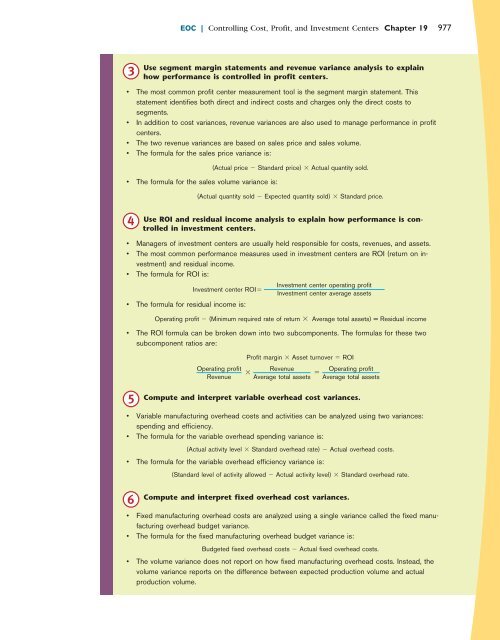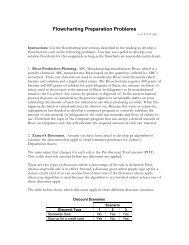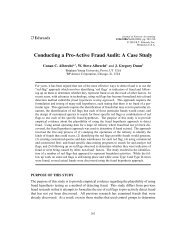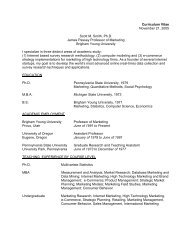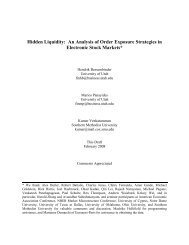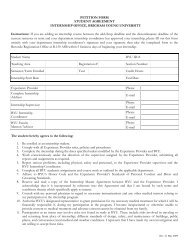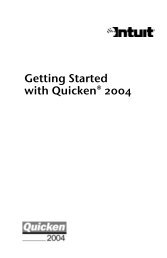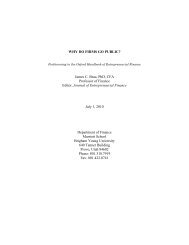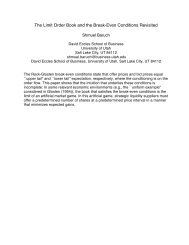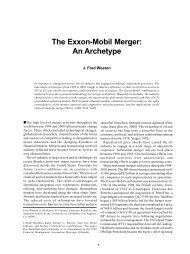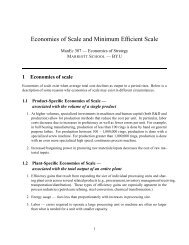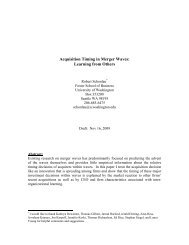Albrecht 19.pdf - Marriott School
Albrecht 19.pdf - Marriott School
Albrecht 19.pdf - Marriott School
You also want an ePaper? Increase the reach of your titles
YUMPU automatically turns print PDFs into web optimized ePapers that Google loves.
76154_23_ch19_p942-1006.qxd 3/1/07 3:35 PM Page 977<br />
EOC | Controlling Cost, Profit, and Investment Centers Chapter 19 977<br />
3<br />
Use segment margin statements and revenue variance analysis to explain<br />
how performance is controlled in profit centers.<br />
• The most common profit center measurement tool is the segment margin statement. This<br />
statement identifies both direct and indirect costs and charges only the direct costs to<br />
segments.<br />
• In addition to cost variances, revenue variances are also used to manage performance in profit<br />
centers.<br />
• The two revenue variances are based on sales price and sales volume.<br />
• The formula for the sales price variance is:<br />
• The formula for the sales volume variance is:<br />
4<br />
(Actual price Standard price) Actual quantity sold.<br />
(Actual quantity sold Expected quantity sold) Standard price.<br />
Use ROI and residual income analysis to explain how performance is controlled<br />
in investment centers.<br />
• Managers of investment centers are usually held responsible for costs, revenues, and assets.<br />
• The most common performance measures used in investment centers are ROI (return on investment)<br />
and residual income.<br />
• The formula for ROI is:<br />
Investment center ROI<br />
• The formula for residual income is:<br />
Operating profit (Minimum required rate of return Average total assets) = Residual income<br />
• The ROI formula can be broken down into two subcomponents. The formulas for these two<br />
subcomponent ratios are:<br />
5<br />
Profit margin Asset turnover ROI<br />
<br />
Compute and interpret variable overhead cost variances.<br />
• Variable manufacturing overhead costs and activities can be analyzed using two variances:<br />
spending and efficiency.<br />
• The formula for the variable overhead spending variance is:<br />
(Actual activity level Standard overhead rate) Actual overhead costs.<br />
• The formula for the variable overhead efficiency variance is:<br />
6<br />
Operating profit<br />
Revenue<br />
Investment center operating profit<br />
Investment center average assets<br />
Revenue<br />
Average total assets<br />
(Standard level of activity allowed Actual activity level) Standard overhead rate.<br />
Compute and interpret fixed overhead cost variances.<br />
• Fixed manufacturing overhead costs are analyzed using a single variance called the fixed manufacturing<br />
overhead budget variance.<br />
• The formula for the fixed manufacturing overhead budget variance is:<br />
Budgeted fixed overhead costs Actual fixed overhead costs.<br />
• The volume variance does not report on how fixed manufacturing overhead costs. Instead, the<br />
volume variance reports on the difference between expected production volume and actual<br />
production volume.<br />
<br />
Operating profit<br />
Average total assets


